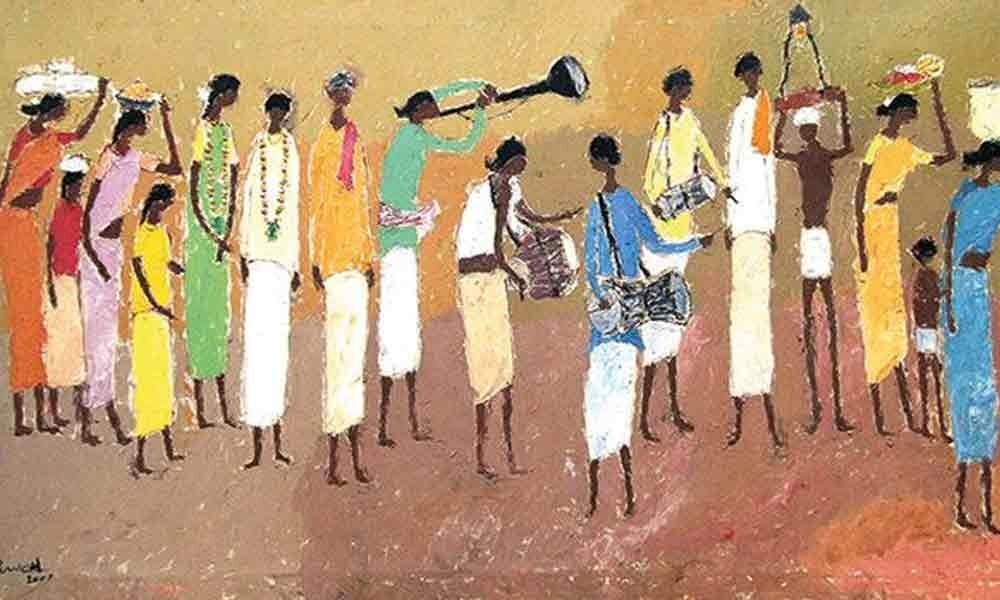Live
- NASA Tracks Five Giant Asteroids on Close Approach to Earth Today
- Pushpa 2 Hits ₹1000 Crore in 6 Days: How It Compares to Other Top Indian Films
- Vivo X200 and X200 Pro Launched in India: Price, Specifications, and Features
- Nitin Gadkari Admits Feeling Embarrassed at Global Summits Over Rising Road Accidents in India
- Comprehensive Review on Indiramma Housing Survey and Welfare Initiatives Conducted via Video Conference
- Jogulamba Temple Records Rs 1.06 Crore Hundi Revenue in 150 Days
- Opposition Slams ‘One Nation, One Election’ Bill as Anti-Democratic; BJP Allies Support the Move
- Celebrate Karthigai Maha Deepam Virtually with Sri Mandir’s LIVE Darshan Experience
- BJP Extends Support to Samagra Shiksha Abhiyan Employees' Strike, Demands Immediate Regularization and Welfare Benefits
- Dr. M. Priyanka Stresses Quality Education, Nutritious Meals, and Cleanliness in Schools
Just In

Modern art in India has long been synonymous with the likes of M F Husain, S H Raza and F N Souza of the Bombay Progressive Movement, so much so that the soaring values of their works almost eclipsed other modernist art movements in the country.
Modern art in India has long been synonymous with the likes of M F Husain, S H Raza and F N Souza of the Bombay Progressive Movement, so much so that the soaring values of their works almost eclipsed other modernist art movements in the country.
The Madras Art Movement (1960s to 1980s) that celebrated all things indigenous was overlooked too, perhaps because of its artistic approach far removed from the European ways of the Bombay Progressives.
But an exhibition in Mumbai hopes to refocus the spotlight on the movement, which came about by default when certain works of artist K C S Paniker, also then principal of the Government School of Arts in Madras, were criticised for its lack of "Indian quotient".
The DAG's (Delhi Art Gallery) show, "Madras Modern: Regionalism and Identity", begins at the Kala Ghoda Gallery in Mumbai on Saturday.
"The critic's remarks made Paniker aware that he needed to move away from the influence of European modernists and look to the regional and canonical tradition to charter a new trajectory," art historian and critic Ashrafi Bhagat, who has curated the show, told PTI.
The retrospective features over 60 paintings and prints, along with 15 sculptures. by artists, including S G Vasudev, K V Haridasan, V Viswanadhan, R M Palaniappan, C Douglas, J Sultan Ali, P Gopinath, Reddeppa Naidu, S Nandagopal, R Santhanaraj, M Suriyamoorthy, L Munuswamy and Kala Nandgopal.
The idea was to look at India's "deathless store of energy" -- its regional folk art and craft traditions, and revisit, revive and reinterpret them through the artists' "modern sensibilities".
Bhagat termed the movement's approach of looking closer to home "nativism", which as a philosophy was region-based. "It derived its vocabulary from inscriptions, kolam designs, folk gods and goddesses, dance accoutrements, folk toys, etc,. and became the common thread of commonality when artists connected with their cultural roots," the historian explained.
It is this affinity with "a regional modernism and identity" that set the Madras art movement apart from the Bombay Progressives, who in the post-Independence phase resisted a return to tradition or indigenism of any kind.
The latter looked towards the European modernists, including the Cubists, Expressionists and abstract artists, to establish their brand of modernism.
The Madras Art Movement, on the other hand, searched for a language of modernity rooted in their own regions. Therefore, it was often localised history, sacred iconography, architecture, mythology and murals that made it to the canvases.
The works were distinctive in their use of decoration and vibrant colours. The movement also focussed on various regional crafts like lithography, wood work, jewellery-making, cabinet making, engraving, enamelling, lacquering, weaving and pottery.
"It was the engagement with the craft processes related to the ideology of nativism or regional crafts and art forms, which gave rise to a practice of articulating with visual vocabulary," Bhagat said.
As far as Bhagat's curatorial vision for the retrospective was concerned, she was convinced she wanted to showcase the works of a core group of artists responsible for developing the movement.
"Those artists whose visual language and vocabulary accorded with the Nativist philosophy became part of the exhibition," she said.
According to Bhagat, the retrospective is an opportunity to make the "extremely important" artists of Madras Art Movement part of the mainstream discourse.
"They need to be better known in India, among collectors and art-lovers, but also internationally, since they represent a certain synthesis of ideas that forms a critical discourse in India's art history," she said.
She added that the movement was also important because it was capable of finding resonance in contemporary India.
For instance, regional affiliations are noteworthy in the works of artists like Laxma Goud and T Vaikuntham, and in the redefinition of folk and tribal arts such as the Madhubani and Warli traditions respectively.
"Ultimately, it is a search for an identity, and the negotiation between the self and the environment that fashions one's responses," she said.
Following the show in Mumbai, where it will continue till October 12, the exhibition will also travel to other cities.

© 2024 Hyderabad Media House Limited/The Hans India. All rights reserved. Powered by hocalwire.com







